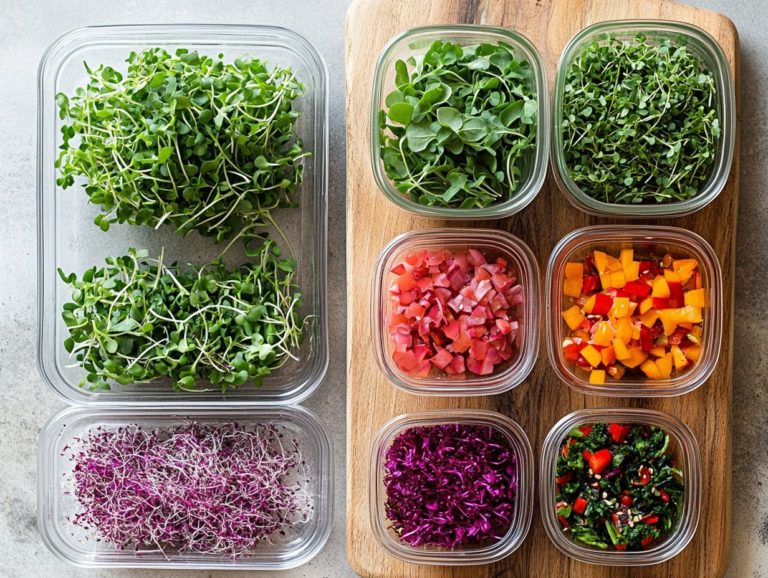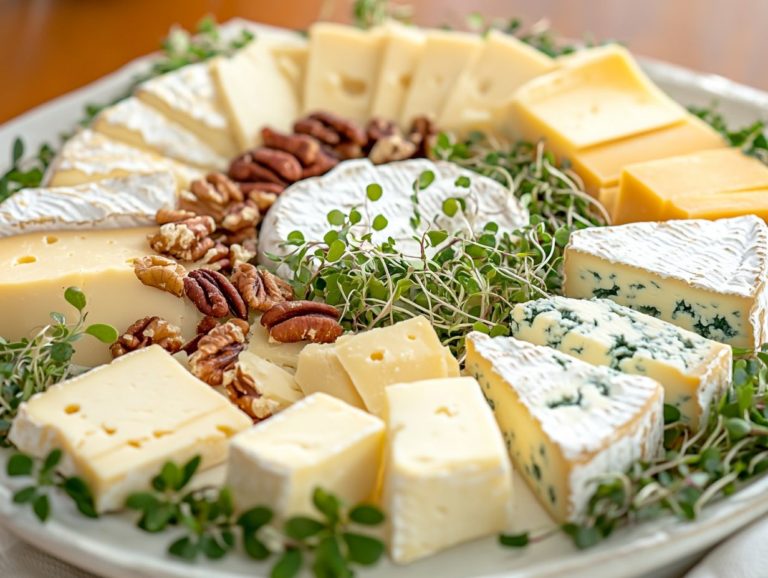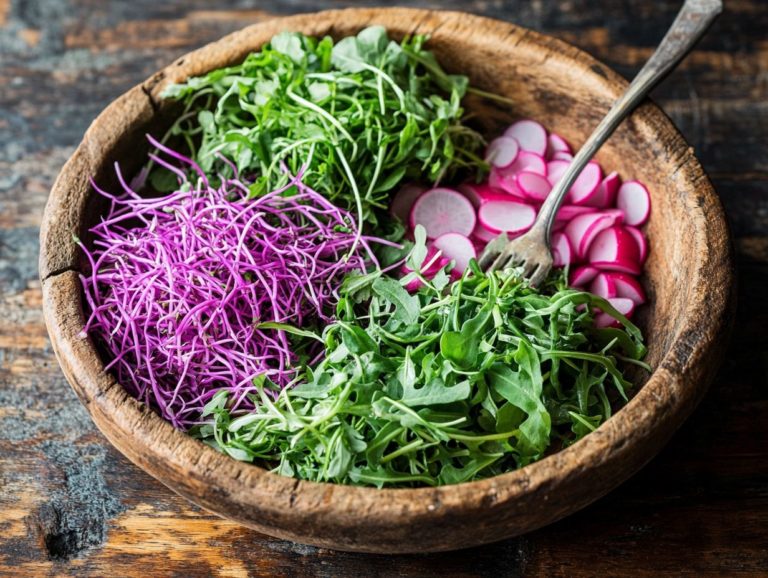8. Elevate Your Dishes with Microgreen Pesto
Microgreens are those petite, nutrient-rich plants that deliver a burst of flavor and a wealth of health benefits.
This article delves into the fascinating world of microgreens, highlighting their remarkable nutritional profile and how they can elevate your culinary creations, particularly in pesto. You ll discover straightforward recipes for crafting delectable microgreen pesto, along with valuable tips for purchasing or cultivating your own vibrant greens. We will also discuss how to store these greens properly.
Get ready to boost your dishes and refresh your cooking with the amazing benefits of microgreens!
Contents
Key Takeaways:
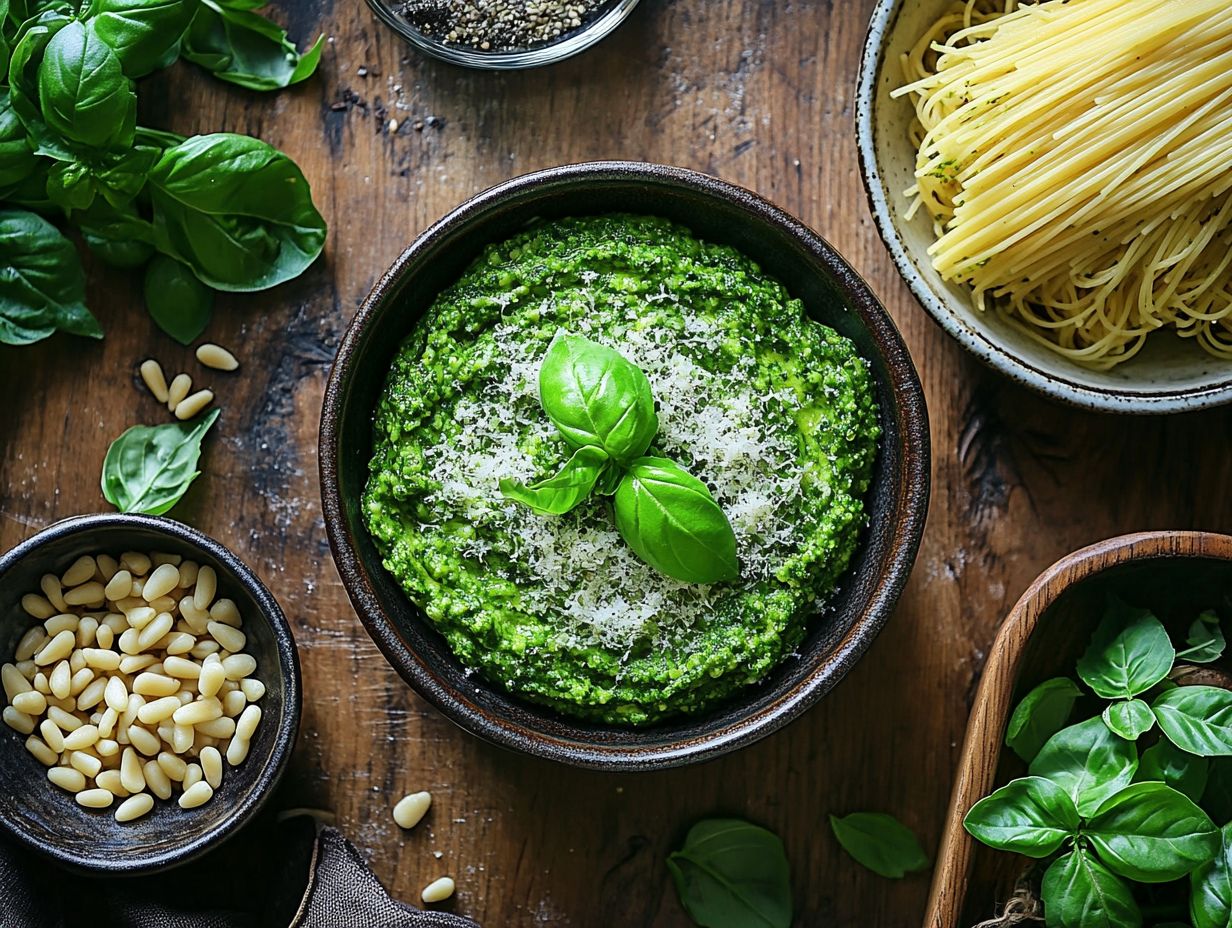
Understanding Microgreens
Microgreens are young edible plants. They bring vibrant colors and robust flavors to your plate.
Varieties such as basil, arugula, and broccoli microgreens showcase their impressive nutritional density. They not only enhance the visual appeal of your dishes but also provide substantial health benefits, making them a superb addition to great options for plant-based protein. For those looking to explore new flavors, creating microgreen infused sauces is a fantastic way to jazz up salads or elevate carb-heavy meals, enriching your diet with essential nutrients.
What are Microgreens?
Microgreens are those delightful young, edible plants you can harvest right after the first true leaves make their debut, offering a vibrant burst of flavor and nutrition.
These petite greens, often sprouted from seeds like basil, kale, or pea shoots, have a remarkably swift growth cycle lasting just 7 to 21 days, making them an incredibly rewarding choice for your home gardening endeavors. Rich in vitamins and antioxidants, they not only add a splash of color to your dishes but also deliver a powerful nutritional boost.
In the culinary realm, these tiny treasures are celebrated for their ability to elevate flavor profiles. You can sprinkle them on salads, tuck them into sandwiches, or use them as garnishes for soups and main courses, enriching your overall dining experience.
The Benefits of Microgreens
Microgreens present a wealth of health benefits, making them the perfect choice for anyone eager to enrich their diet with foods rich in nutrients.
These petite greens are brimming with vitamins, minerals, and antioxidants, serving as a powerful nutritional boost that fosters overall well-being. Research indicates that microgreens can pack up to 40 times more nutrients than their fully grown counterparts, making them essential for those on the hunt for vegetarian protein sources.
By incorporating varieties like broccoli microgreens and spicy radish into your meals, you can dramatically enhance your nutrient intake.
Nutritional Value and Health Benefits
The nutritional value of microgreens is truly remarkable, as they often boast a wealth of vitamins, antioxidants, and essential nutrients.
These tiny greens deliver a powerful punch, with varieties like broccoli and kale packed with high levels of vitamins A, C, and K. These vitamins play crucial roles in promoting skin health, boosting your immune system, and supporting bone density. Additionally, minerals such as iron and magnesium found in microgreens are essential for energy production and muscle function. The impressive concentration of antioxidants helps your body combat oxidative stress, enhancing your overall wellness.
By incorporating a mix of microgreens into your daily meals, you can enjoy a delicious and nutritious boost, making it easier to achieve a well-balanced diet.
Start experimenting with microgreens today and see how they can transform your meals!
Using Microgreens in Pesto
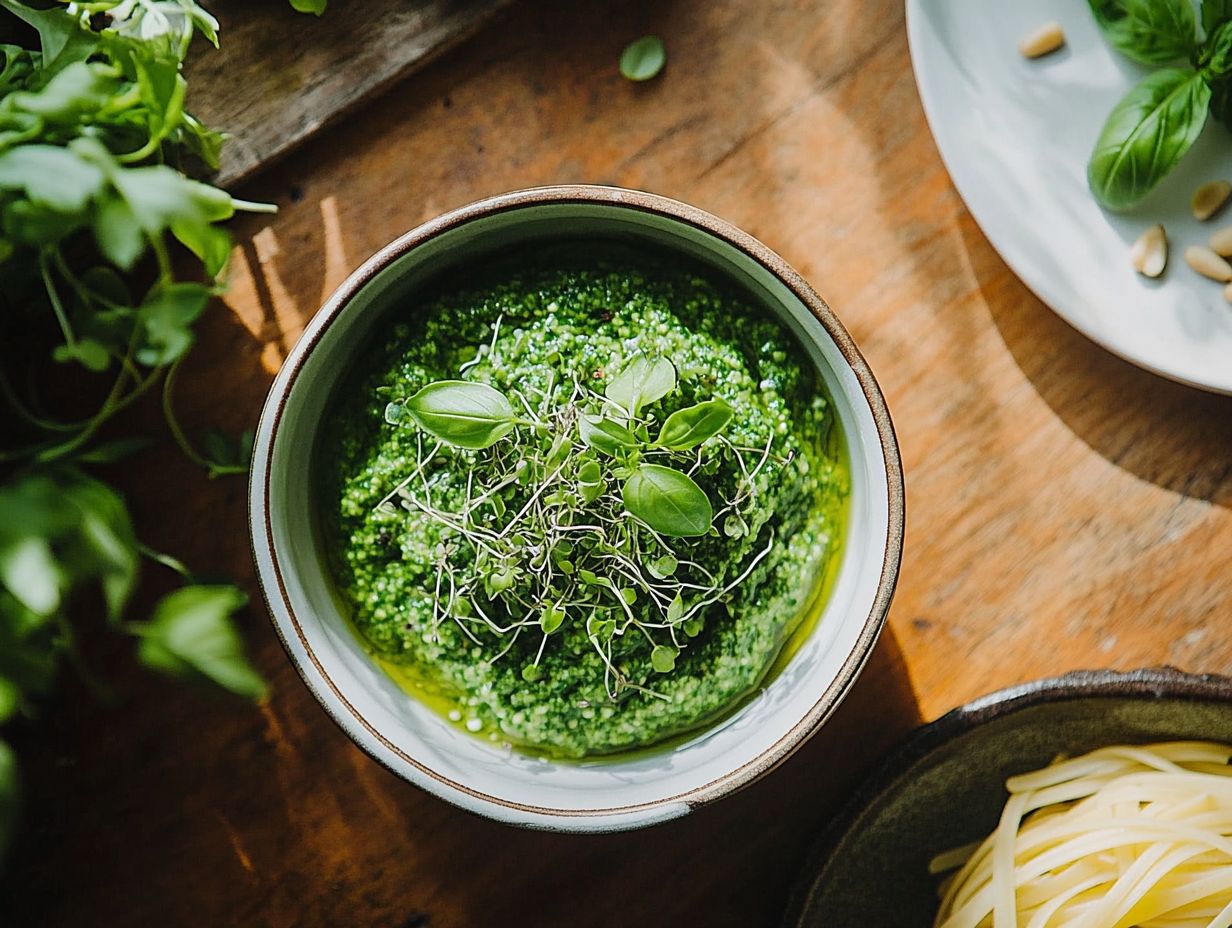
Incorporating microgreens into your pesto elevates this classic sauce. It adds a delightful twist that enhances both flavor and nutrition. While traditional pesto relies on basil, garlic, and olive oil, you can substitute or complement these ingredients with microgreens like arugula or broccoli. This approach allows you to craft a unique and healthy blend that transforms your cooking experience.
Whether you’re slathering it on avocado toast or drizzling it over a fresh salad, microgreen pesto offers an innovative and healthful way to embrace the benefits of these tiny powerhouses. For a deeper dive into using these ingredients, check out our microgreens in Italian cuisine: recipe guide.
How to Incorporate Microgreens into Pesto
To elevate your pesto sauce, begin by selecting your favorite microgreens, such as basil microgreens or spicy radish, to enhance its flavor. These tiny greens not only infuse a burst of vibrant taste but also deliver a significant nutritional boost, making your dish both healthier and more exciting.
Start by gathering about two cups of your chosen microgreens, which will serve as the base of your pesto. Then, blend them with a handful of nuts—pine nuts or walnuts work wonders to create a rich texture. For added inspiration, consider using microgreen toppings to elevate your dish. Next, incorporate a few cloves of garlic, a generous drizzle of high-quality olive oil, and some grated Parmesan cheese to beautifully round out the flavors.
Pulse the mixture in a food processor until it reaches your desired consistency. Ensure that all ingredients meld seamlessly. For an added layer of flavor, consider squeezing in some lemon juice or adding a touch of zest.
This pesto is super versatile! You can toss it with pasta, spread it on sandwiches, or use it as a dip, making it a delightful addition to your cooking options.
Recipes for Microgreen Pesto
Exploring microgreen recipes reveals many creative ways to use them, with pesto standing out as a star player. Whether you stick to the classic basil version or venture into exciting variations featuring arugula microgreens or zesty radish, the possibilities are truly endless.
By incorporating these nutrient-packed greens, you not only elevate the flavor of your pesto but also enrich its nutritional value. This versatile sauce can enhance pasta, elevate sandwiches, or serve as a dressing for salads. Microgreen pesto is essential for anyone eager to refine their cooking skills.
Simple and Creative Pesto Recipes
Simple and creative microgreen recipes can transform your pesto into a unique culinary experience.
By using a variety of microgreens—think basil sprouts, radish greens, or sunflower shoots—you can elevate traditional pesto to exciting new heights. Each microgreen contributes its own distinct flavors and textures, making the sauce not only more vibrant but also full of nutrients. For even more inspiration, explore unique microgreens to elevate your dishes.
Adding kale microgreens introduces an earthy richness, while wasabi arugula sprouts deliver a delightful kick. This versatility makes microgreens an ideal choice for health-conscious food enthusiasts eager to enhance their dishes.
Whether you serve your inventive pesto atop pasta, as a spread on sandwiches, or drizzled over roasted vegetables, these variations are sure to be both visually captivating and deliciously nutritious.
Where to Find Microgreens
Discovering microgreens is a breeze whether you prefer a quick trip to your local grocery store or the satisfaction of cultivating them at home. Health-conscious individuals are increasingly drawn to microgreens for their remarkable health benefits and vibrant flavors, creating a flourishing market both in stores and online.
Infinity Fresh exemplifies a retailer that specializes in offering a diverse selection of fresh microgreens, making it effortless for you to access these nutrient-packed greens. No matter if you decide to purchase them or grow your own, integrating microgreens into your diet can be a truly rewarding experience.
Try these recipes today and discover the joy of cooking with microgreens! Visit your local store or order online today to start enjoying the benefits of microgreens!
Buying or Growing Your Own Microgreens
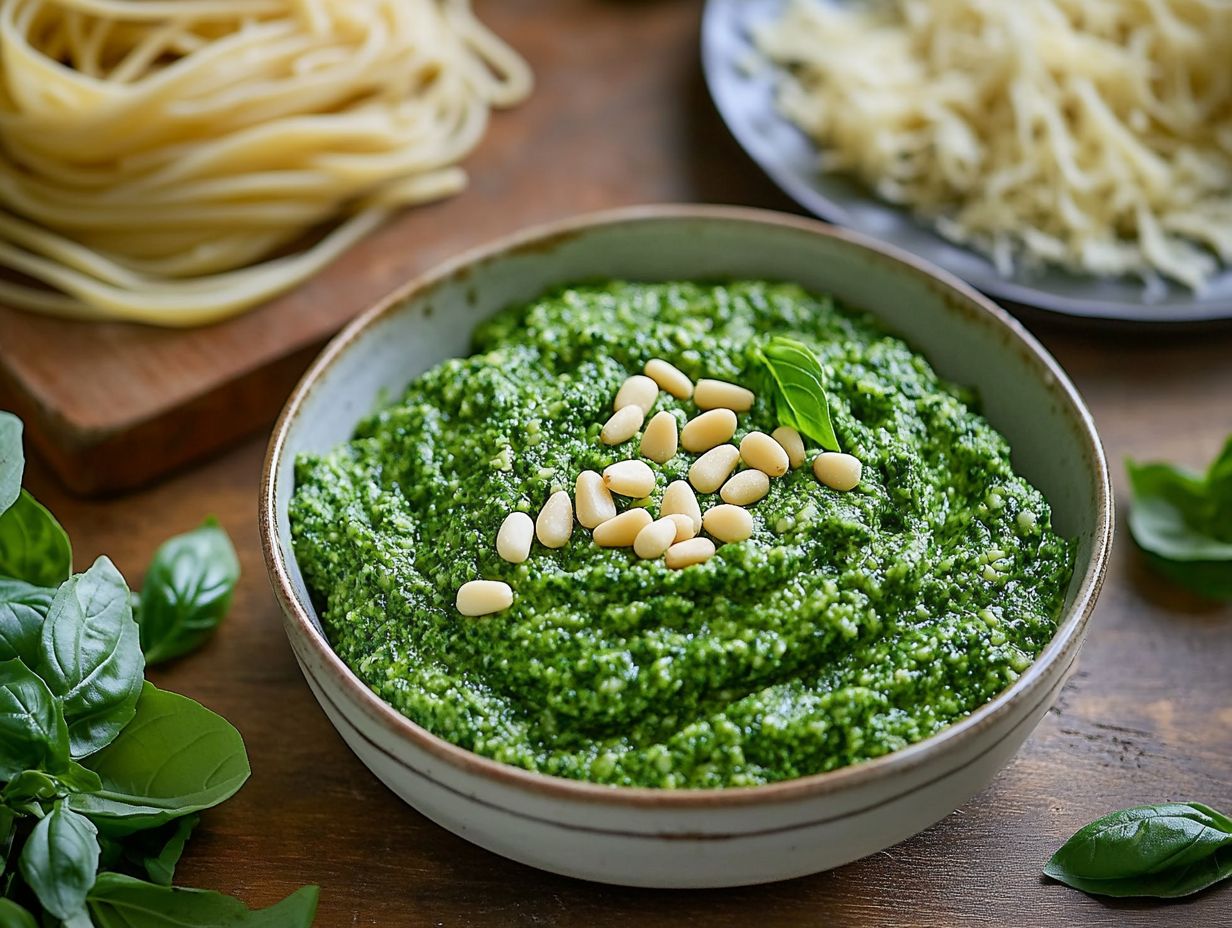
You can either purchase microgreens from stores or grow them at home in a garden setup.
Both options have their own unique advantages and challenges.
Buying microgreens from local supermarkets often guarantees freshness and convenience. This allows you to enjoy various flavors without committing to gardening.
On the other hand, growing them at home deepens your connection to the food and provides the rewarding satisfaction of nurturing plants from seed to harvest.
If you’re ready to start growing microgreens at home, you’ll need a few basic supplies: seeds, a growing medium (which is the material that supports plant growth, such as soil or coconut coir), shallow trays, and a reliable light source.
Creating a well-drained environment will encourage healthy growth, making the process both rewarding and accessible.
Tips for Using and Storing Microgreens
Understanding how to use and store microgreens is essential for enjoying their vibrant flavor and health benefits.
These delicate greens require attention to maintain their freshness, ensuring they deliver maximum flavor to your dishes.
Proper storage methods can extend the shelf life of your microgreens, keeping them nutrient-dense for longer whether you re adding them to stir fry, salads, or smoothies.
Mastering how to incorporate these greens into your cooking will enhance both the taste and nutritional profile of your meals.
Maximizing Freshness and Flavor
Maximizing the freshness and flavor of microgreens is crucial for enjoying their unique taste and health benefits.
To achieve this, employing proper storage techniques is key. These tiny greens flourish in cool temperatures.
Refrigerating them in a moisture-controlled environment helps preserve their crispness and vibrant color.
Ideally, consume microgreens within a week of harvesting to fully appreciate their robust flavors and impressive nutritional benefits.
Store them in a breathable container lined with a slightly damp paper towel to extend their lifespan while minimizing spoilage.
Remember, the fresher the microgreens, the more intense their flavor enhancing any dish and delivering a powerful nutrient punch.
Incorporating Microgreens into Your Cooking Routine
Adding microgreens to your cooking can elevate both the flavor and nutritional profile of your meals.
Imagine sprinkling them on salads to create a vibrant burst of color while packing in essential nutrients.
Consider blending them into smoothies for an extra health boost.
When preparing stir fries, toss in a handful just before serving for a delightful crunch and fresh flavors.
Whether adding them to omelets or using them as a garnish for your favorite soups, the possibilities to enjoy the robust taste and health benefits of microgreens are endless.
Frequently Asked Questions
What are microgreens?
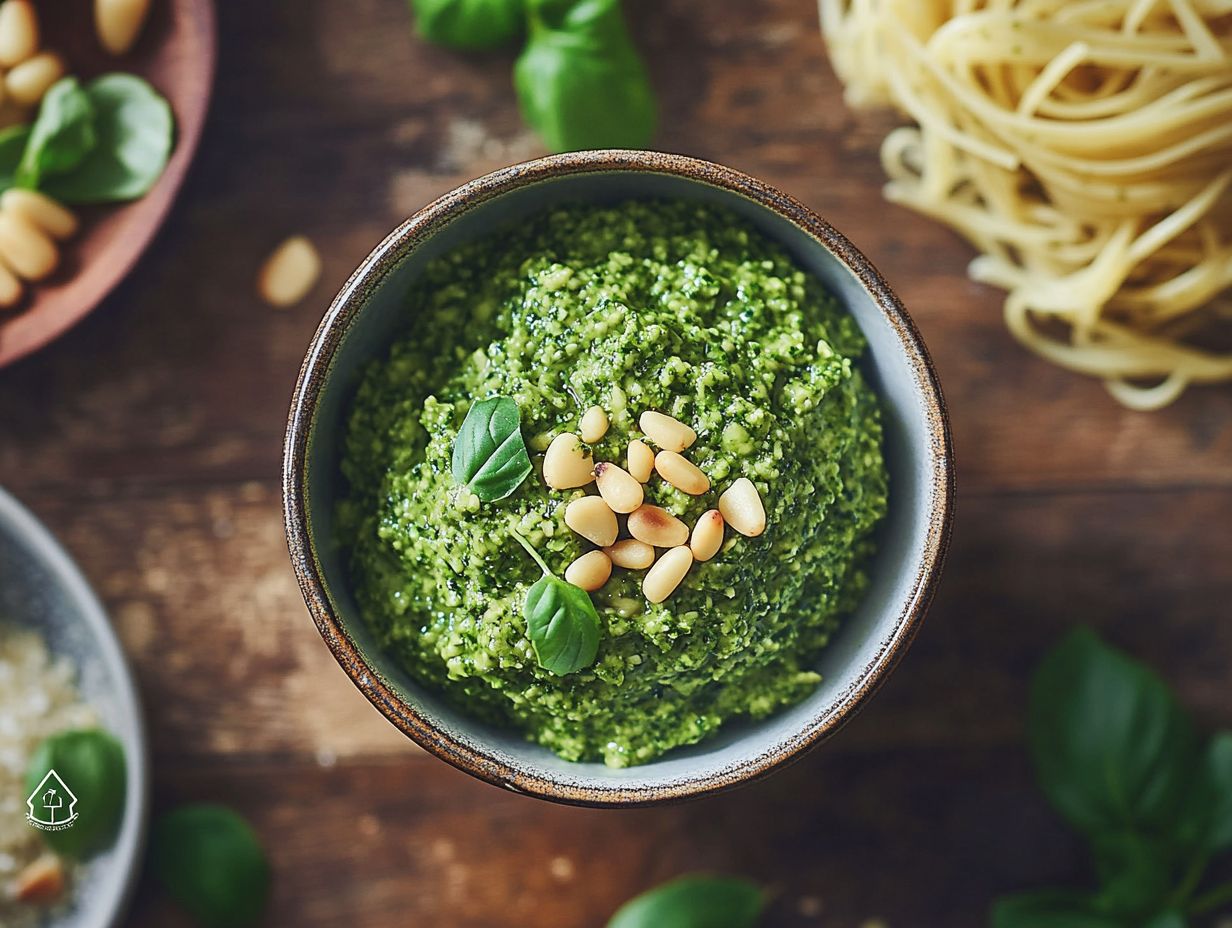
Microgreens are young, tender, edible greens harvested after the first true leaves develop. They are packed with nutrients and have a strong, concentrated flavor.
What is microgreen pesto?
Microgreen pesto is a twist on traditional pesto, made with microgreens instead of basil. It is a flavorful and nutrient-rich sauce perfect for topping or dipping various dishes.
How do I make microgreen pesto?
To make microgreen pesto, blend microgreens, garlic, nuts, cheese, and olive oil until smooth. Add lemon juice or other herbs for extra flavor and adjust the ingredients to your preference.
What dishes can I use microgreen pesto on?
Microgreen pesto enhances a variety of dishes, including pasta, salads, sandwiches, pizza, and even as a marinade for meats. It adds a burst of flavor and nutrition to any meal.
Try growing your own microgreens or experiment with microgreen pesto in your dishes for a fresh and healthy twist!
Are all microgreens suitable for making pesto?
No, not all microgreens are suitable for making pesto.
Use microgreens with strong flavors like arugula, basil, cilantro, parsley, or kale.
Try different varieties to discover your favorite!
Can I store microgreen pesto?
Absolutely! You can keep microgreen pesto fresh in an airtight container in the fridge for a week.
Want to enjoy it longer? Freeze it in an ice cube tray and store the cubes in a freezer bag for future use!


